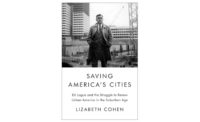A Vision by Peter Greenaway at the Park Avenue Armory
You had to be there. A hyperbolic production that fuses the hokey theatricality of “son et lumière” (sound and light) tourist attractions with the razzle-dazzle antics of Cirque du Soleil was on view at the Park Avenue Armory in New York City until January 6, 2011. Leonardo’s Last Supper: A Vision by Peter Greenaway, a kitschy, multimedia spectacular (kitschtacular?), is basically a photographic reconstitution of da Vinci’s famous fresco, punched up by films, lighting, music, and voice-overs. Masterminded by Greenaway, the Welsh-born impresario, filmmaker, and artist (with a strong interest in architecture), this splashily souped-up phantasmagoria sought to heighten the experience of a work of art painted in 1498 for the convent refectory at Milan’s Santa Maria delle Grazie.
The original fresco remains in Milan, fragilely holding onto its aura, while its “clone,” as it is called by Factum Arte, the Madrid- and London-based digital production company that created the photographic facsimile, has been painstakingly mounted here in an exactly dimensioned, abstractly rendered reconstruction of the chapel and refectory. The Last Supper clone owes its physical (but not spiritual) substance to high-resolution images made with three-dimensional scanning machines and ink-jet printers rolling over plaster panels mounted on aluminum sheets.
Greenaway’s overwrought production begins with a prologue in which glimpses of Italian Renaissance and Baroque architecture flash on gigantic wall-like screens while a film shows a male ballet dancer in a white loincloth (yes!) prancing from scrim to scrim, and white doves flutter by against a pale blue sky.
The tripartite event ends with a digital presentation of Paolo Veronese’s painting Wedding at Cana (1563), now hanging in the Louvre. In this didactic three- and two-dimensional staging, wedding guests are circled in red and scenes are diagrammed, also helpfully in red, to impart what is going on in the painting. You may get lost when virtual rain starts to hail down on one and all in this digital overdrive.
In his much-cited essay of 1936, “The Work of Art in the Age of Mechanical Reproduction,” Walter Benjamin defended film and its “exhibition value.” He noted, but did not regret, the loss of the “aura” of the traditional painting viewed one-on-one. Maybe Greenaway was thinking of Benjamin. But in the age of digital reproduction, sheer amplitude of technical effects, by their very distraction, easily catapult exhibition values into a lurid, Sturm-und-Drang sentimentality. Greenaway’s concoction makes Andy Warhol’s Pop homages to The Last Supper (1984) look downright ascetic.
This romanticized farrago does offer one socially redeeming value. It attracted a large art-worshipping public to the 19th-century landmark, which is undergoing a skillful restoration. The Gothic Revival armory, designed in 1881 by Charles Clinton, with rooms by Louis C. Tiffany and Stanford White, is architecture, in genuine, unmediated splendor.



















Post a comment to this article
Report Abusive Comment